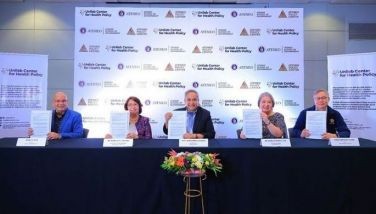Tapping water technology

For an archipelago like the Philippines surrounded by large bodies of water like seas and ocean, our country has been barely utilizing the full potentials of our vast expanse of water and marine resources. Although well-endowed with such God-given natural resources, we suffer water supply shortage year in and year out. We experience prolonged period of El Niño or dry spell that experts blame on climate change.
While it is indeed partly due to climate change, there is also the opposite weather condition called La Niña or wet spell, referring to the unusually lengthy rainy season. And during such wet season, we get inundated by severe flooding. Sadly, our bureaucratic set up has been so fragmented in tapping the full potentials of our natural wealth like water resources that our country enjoys.
Thus, it was not surprising when Malacañang Palace announced yesterday that President Ferdinand “Bongbong” Marcos Jr. (PBBM) has revived the long pending administration’s priority bill seeking to establish a single water agency to ensure that Filipinos would have access to clean water. To this end, PBBM directed various water-related government agencies during a sectoral meeting held last Feb. 25 at Malacañang on the proposed Department of Water Resources (DWR) bill.
“I’ve instructed government agencies to refine the Department of Water Resources bill to create a clear and effective framework that cuts inefficiencies, strengthens regulation and ensures clean, reliable water for every Filipino,” the President posted in his Facebook social media account.
The DWR bill was one of the 19 priority measures identified by the President during his second State of the Nation Address in July 2023. While awaiting the enactment of the bill, PBBM issued Executive Order (EO) No. 22 that created an interim body called the Water Resources Management Office (WRMO). EO 22 tasked this inter-agency body to consolidate government efforts to ensure the sustainable management of water resources.
“To avert a water crisis, minimize and avoid conflicts and consistent with the state’s sole ownership and control over the country’s water resources,” the President cited in EO 22 to justify the creation of this interim transition body. More than two years later and PBBM is already in his mid-term in office, the DWR remains stuck in the legislative mill of the 19th Congress. PBBM has yet to certify DWR bill as an urgent administration measure if it is to get approved before the 19th Congress bows out on June 30 this year.
Fortunately, the government’s slack in providing for new potable water sources is being more than filled by the more pro-active private business sector. The biggest of these was the ground-breaking last week of the country’s biggest seawater desalination facility being put up by the Metro Pacific Water Investments, Corp. (MPWIC) in Iloilo City.
Through a tie-up with global French desalination technology company Suez, the water from the sea can now be tapped as potable water under the P5.5-billion project. MPWIC chief finance officer Jose Mari Lazo announced in our Kapihan sa Manila Bay news forum last Wednesday that the desalination facility is expected to become operational in 2027. Not only will the project ensure enough water supply in the province, Lazo cited, it will also boost the government’s effort to provide “alternative” sources of water.
“The problem with the traditional sources like fresh water, dam water, they are prone to vulnerability of climate change. If there is drought, you will have shortage of water and it is possible that your ground water will be contaminated. This (desalination project) is a game changer as you are now tapping into sea water, which is vast and abundant,” Lazo pointed out.
About 97 percent of the water source, Lazo cited, comes from seawater and only about 2.5 percent is sourced from freshwater. “Fraction of that is where we are tapping for potable water,” Lazo noted. The desalination facility will directly harvest seawater through pipes that will be installed 12 meters below sea surface, Lazo said.
Lazo explained that Metro Pacific and Suez will be bringing in the “reverse osmosis” technology which will turn salt water into potable drinking water. The desalination facility is specifically being put up near the coast facing the sea between Guimaras and Iloilo. “We are getting directly from the sea which means there is high level of salt and definitely the technology is different in treating this,” he added.
The Iloilo Desalination Project will be the largest of its kind in the Philippines.
“It will have a capacity of 66.5 million liters per day. It will benefit about 400,000 residents and businesses in the Iloilo region,” Lazo pointed out. The MPWIC partnered with Suez, a France-based water and waste management solutions provider which will assist in the construction and operation of the desalination facility in Barangay Ingore, La Paz, Iloilo City.
A 10-year-old company, MPWIC is one of the companies under the flagship of industrialist/businessman Manny V. Pangilinan of the Metro Pacific Investments Corp. (MPIC). Its sister company is Maynilad Water Services, one of the two water concessionaires servicing the potable water needs in Metro Manila, sourced from river and lake dams in Luzon.
The desalination facility requires intensive use of energy, Lazo admitted. Thus, MPWIC also partnered with the Iloilo City government headed by Mayor Jerry Treñas on waste-to-energy bio-mass power plant. The 3.5-megawatt bio-mass plant will be powered by the garbage collections around the city. According to Lazo, the city government will supply at least 470 tons of garbage per day that will be processed to generate the electricity that will partially supply the energy needs of the desalination facility.
He believes the Iloilo desalination facility will run under cost-efficient technology to make its pricing consumer-friendly. Lazo reassured Iloilo residents that MPWIC is collaborating with the local water utilities, local government units and the national government to ensure mechanisms that will ensure that the basic need for safe drinking water will be affordable to consumers.
Tapping this technology that could avert water scarcity deserves scaling up across the Philippines.
- Latest
- Trending































